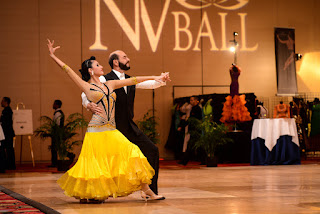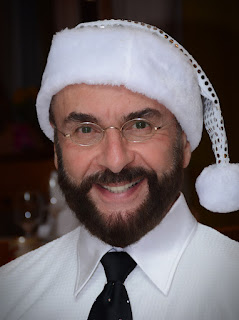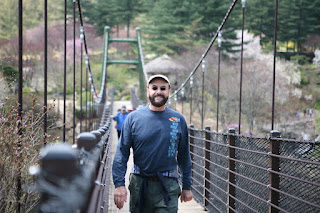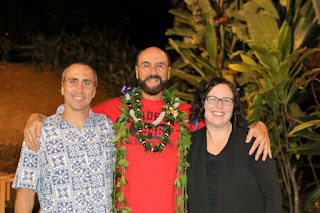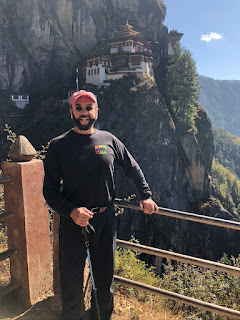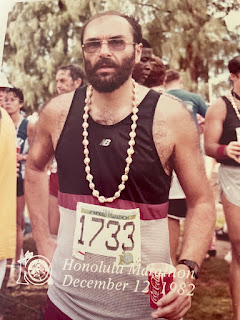Stepping Lightly
This is NOW 2025- Chapter 7 in the life of David Easa......entering a new chapter in retirement, living for today, hoping for tomorrow, while always stepping lightly.......
Thursday, November 20, 2025
Seventy Nine Years Old - Yikes, That's OLD!
Saturday, October 4, 2025
Hokkaido –Second Impressions - 2025. Where can I put my garbage?
Having been in Hokkaido earlier this year for the Snow Festival made me want to return this fall. And so here we are and for the most part, so are the beautiful vibrant array of fall colors! It’s a much different vibe; the weather is perfect; people are walking everywhere both at street level and below in the labyrinth of underground pathways. It feels safe, it IS safe, children, adolescents, mature adults and senior citizens all make for a visually pleasant menagerie for people gazing. It makes me feel old to see so many vibrant youths, but I’m out there with them which beats the alternative. Many things are the same; some are different. Thank God for Daiso, thank God for Donkey (Don Quixote).
Still only a smattering of westerners, mostly Japanese found living the life. Hokkaido Food Festival provides hundreds of stalls to taste an immense variety of Japanese culinary choices, plus a few from other worlds – Indian, Italian, etc. The food in Japan is of course typically outstanding and if we needed to, we could live on the food sold at any 7 11 for the rest of eternity.
When I first travelled to mainland Japan (Yokohama), everyone on the street was in tailored suits and ties, the women were dressed impeccably, and the formality and the does and don’t were firmly imbedded and palpable. Fast forward to the present, at least in Sapporo, individuality and comfort rule the day. Even those wearing suits may not include ties. But many wear t-shirts or loose-fitting shirts and pants, baggy low-lying shorts, and nondescript sweatshirts and hoodies. The women are also dressed casually. Loose fitting garments, dark or dowdy colors, dresses that reach the ankles or even lower, pants and t-shirts, etc, etc. There are still some fashionably dressed and then there are the teenage girls dressed in whatever is acceptable for their peers, some fancy, some fanciful, some a little outrageous!
While Gerri loves to explore every item in every aisle in every Diaso and the impossible task of repeating this routine in the Mega Don Quijote, I really enjoy walking the streets, looking for the fall colors, exploring the architecture and landscapes, and people watching. We also visited some beautiful sites in the Daisetsuzan National Park, Biei and Furano. But this time I also wanted to know how Japan can keep so clean and orderly. Indeed, I believe you can even perform heart surgery on any street in Japan and not worry about contamination or secondary infection….
In the US, it is axiomatic that if you wanted to encourage the proper disposal of waste in public spaces, you would place garbage bins in enough locations to discourage those likely to default to littering anywhere and everywhere. It works for the most part but never completely and even in Hawaii, litter can sometimes be found but nothing compared with where littering is King in places like New York City. Japan has a unique solution to littering – eliminate garbage bins altogether and place the burden on the individual to collect and dispose of litter after returning home. So there are virtually no garbage bins anywhere out in the open….if you had a wrapper that you wanted to discard at 7-11, the attendants will willingly accept it assuming it was generated from a prior sale.
And it’s remarkable that even in Haneda Airport, thousands of travelers from all over the world contribute to keeping it the cleanest airport in the world! Enough signs and individual expectations placed on those transiting the airport as well as a dedicated staff of housecleaners patrolling the common areas looking to correct the occasional refuse infraction and scouring areas on the carpet or tile that look stained. Even in the Food Festival that we attended, where tons of refuse would be expected to be generated, instead of garbage bins, there were Garbage Stations! You would surrender your garbage at these stations, and the small army of volunteers would process them into the proper category for disposal or recycle, etc.
Not everything in Japan is hunky dory. I’m still miffed at the requirement that requesting for a one-hour extension on check out of your hotel will generate a cost. And even if your room is ready at 2pm, you won’t be able to access it until 3 or 4 pm depending upon the hotel. This aspect is not as friendly or inviting as hotels in the US or elsewhere. It’s still a small price to being in one of the most inviting places on earth to visit, filled with an endless landscape of sites and activities, safe and respectful, with a homogenous, kind and considerate populace that prides themselves on proper human interaction and helping others. More on Japan in the next chapter – next may when we venture on the Japanese cruise ship, the Mitsui Ocean Fuji.
One last item. Yesterday we went to a famous Ramen Shop - Sapporo Ramen Haruka. It was quite an experience. Always a line to wait before entering this tiny enclosure with only counter seating for about 10 people. We had to wait about 30 minutes to allow three others in front of us to gain entrance. A nice gent from Singapore added to the entertainment until entering. The room was very cozy, half the size of my hotel room, and there were tiny stools that were meant to fit the average Japanese derriere, and not the plus sizes of many American tourists. Everyone was crowded in like sardines waiting patiently for the hot bowel of ramen to be served. You witnessed the process as the three working there were busy mixing the various ingredients into each bowel, vats of smoldering soup waiting for the ramen to cook to complete the process and then the fun began. My selection was a cheese ramen dish that I had never heard of before, but it was truly delicious and satisfying. Gerri ordered the miso butter corn selection that was also excellent. The experience was a memorable one that I enjoyed immensely!
Thursday, October 2, 2025
Surviving Haneda Airport T3 to T1 International to Domestic Flight Connection on JAL
October 2025: If it wasn’t for my good friend and fellow Japanophile Ken, with only a 90-minute layover, I would not have made my connecting flight from Haneda Airport Terminal 3 (T3) to Asahikawa departing from Terminal 1 (T1). The information below represents my experience on Japan Airlines connecting from an international flight from Honolulu, Hawaii to Haneda at Terminal 3 to Terminal 1 (approx. 4 km away) where I made my connection to Asahikawa within a 90-minute window. I will forgo any discussion of the free airport bus, the Keikyu line, or the Monorail that connect the three terminals until after the essentials.
Here are the essentials:
• Make sure you logon to Visit Japan Web, fill out the necessary info, and receive a QR code for each traveler in your party. This will save tons of time when passing through Japan’s customs and immigration. Best to take a screen shot on your phone, a paper printout image is a bit more difficult to capture on their monitoring screens.
• After completing the arduous task of navigating hundreds/thousands of tourists at customs and immigration (only took about 20 min thanks to our QR codes and specially directed queues) with all of your luggage in tow, exit into the arrivals lobby where an information desk can easily be seen, bypass this for now into the heart of the terminal and stay focused. TURN Right and walk to nearly the end of the terminal.
• On your left side you will see the Domestic Check in counter…..maybe 50-75 yards…just guessing….only took 3-4 minutes when walking briskly. Assuming you have domestic boarding passes already in hand, you can drop off your luggage and free yourself of having to lug them to T1. Hooray!!! One caveat! Presumably you need to arrive at the Check In counter one hour prior to your departure time or they will tell you to skedaddle to Terminal 1 on your own on one of three options….free bus, Keikyu Line, Monorail. Obviously, I did not test this limitation, but Japan is not known for its lax regulations.
• After completing your business at the Domestic Check In counter, turn to the right (between a quarter and a half turn) and you will see a security check point on the opposite side at the far catty-corner of T3 – Security Check point for Domestic Flights….only about 150 feet from the domestic check in counter. Navigate through this security check point and an escalator will take you down to the ground floor to catch a dedicated, free bus that takes you directly to either terminal 1 or 2. Buses come every few minutes to shuffle you directly to your gate without having to navigate through any further checkpoints or security. Wow, this last feature is what is missing from most of the previous descriptions of how to get from T3 to T1. You only need to get to your gate - the latest 10 minutes prior to departure.
• Refer to this excellent map of T3 shared with me from Ken. https://urldefense.com/v3/__https://tokyo-haneda.com/en/floor/terminal3/2nd_floor.html__;!!PvDODwlR4mBZyAb0!StstouITJdUovGbTifST2Q55vA_ujvzu36NBOer8uOHP0lETVnFHO9J30g-pwoBQjS-MuWWEf4p6nRm1rw$
The Saga:
When I booked my flight to Hokkaido, I jumped at a business class fare that included a legal 90-minute transit time to catch my domestic flight from Tokyo to Asahikawa. I did not fully comprehend what was needed to accomplish during that 90-minute period until after the fact….exit the plane, find your way to immigration and customs, navigate the long queues, present your QR code, get through to the maze of confusion, find your luggage at baggage claim, one final checkpoint, pass into the arrival area, decide how best to navigate to T1 – by free bus, Keikyu Line or Monorail, check in your baggage at T1’s JAL check in counter if outside the one hour window prior to departure, go through security, find your gate, and pray that you have made it in time before the doors close and you are left hopelessly defeated in this marathon endeavor. This caused me unnecessary anguish during the preceding months prior to my journey. I won’t reveal the extent of my musings or actions, but they were considerable including trying to change my connecting flight on several occasions, informing the JR Inn in Asahikawa that I might not make my first night’s booking, etc.
Looking for help on the internet was no help! The pros and cons of the different methods to transit from T3 to T1, how to get a free shuttle bus ride (often long queues and longer transit time than other options) on the Monorail (need to change trains) or Keikyu line to T1 and T2 (lets you off between 1&2, need to walk a few hundred yards to either terminal), rushing to the Domestic check in counter to deliver your luggage prior to the one-hour deadline, and ruminations on Reddit from others with short layover times resembling my dilemma. It all seemed at best a crap shoot. There were just too many options. But none of them made any sense in terms of coordination until JAL had the good sense to make it easy on those transiting from T3 to T1 with their short, but legal layover times that they offered. This new sequence is a welcomed improvement, one that should have been available in the past, but one that will make life more pleasant for countless others in the future.
The Lesson Learned
• Don’t worry about things that you don’t have any control over! Easier said than done!!!
• Do your homework regarding connecting flights and terminal changes and distances between terminals and security clearance and preparing for immigration and customs before booking flights with complex or domestic connections. As a default allow 2 hours between connections.
• Review the layout of terminals that you will be travelling through – For example, You Tube is replete with videos of Haneda Airport terminals. The map referred to above is the best one to refer to.
Postscript
Why am I publishing this in my blog that only a handful of friends read? I could answer some Reddit post or find some other widely read forum to use to get through to the largest audience. I do want to help people but I’m also curious about how many hits I will get from this post.
Wednesday, June 25, 2025
How to Clean Your Eyeglasses!
It’s taken me 60 years to figure out how to clean my prescription eyeglasses without scratching the increasingly fragile, scratchable lenses that seem to invite a progressive infiltration of vision upending damage characterized by a progressive erosion and distortion of ones excessively priced prescription lenses without meaningful recourse. How about this for a run-on sentence!!!
Using microfiber cloths to clean with or without some commercial concoction of water and isopropyl alcohol misses the point as much as using your t-shirt, towel, or any other garment available at the moment to wipe the current smudge clean. A little scratch appears which invites you to rub harder to no avail other than to continue to aggravate and perpetuate the failure of the last cleaning while deepening the scratches and smudges.
The problem is that any residue, any dust, face or hair lotion, or foreign microparticles of unknown origin that reside on your lenses may serve as a nidus of injury when rubbed firmly, even if performed by a clean microfiber cloth. Microfiber has all sorts of attributes that presumably make it ideal for cleaning glasses but, even when I wash the microfiber clothes and rotate a stack of 20 of them each day to clean my lenses, scratches appear and progress over time. Over the last 3 years I have had to replace my favorite glasses twice after they have become so scratched up that my already failing vision seemed even worse when they were perched on the bridge of my nose. Microfiber may indeed forestall the progression to some extent, but it has no magical attributes to completely prevent the process of deterioration.
What we are told to do and what makes common sense may be two different things. With my new pair of lenses just purchased, my goal is to totally avoid any wiping of my lenses during the cleaning process. How do I do that?
I wash the glasses in any sink and after a thorough rinsing of any prevailing residue and discrete particulate matter, I use a gentle soap to coat the lenses while continuing the running water routine. Naturally my hands have been washed prior to this procedure and I avoid using any rough spots on my fingers to do the rubbing. This only takes a few seconds. Then I rinse the soapy water off of the lenses, dry my hands and then instead of wiping my glasses, I resort to a WOLFBOX MF50 Electric Air Duster-110000RPM Super Power Cordless Air Duster, 3-Gear Adjustable Mini Blower to blow the water beads and other micro residue particles off of the lenses. This takes about 5 seconds and does a marvelous job.
So far, NO scratches!!! It’s been about a month since starting this routine. Only time will tell whether this approach weathers the test of time. If it doesn’t, I’m not likely to confess this in a future blog. On the other hand, I feel quite certain that if I can keep to this routine, I will be happily rewarded. To this extent, it is notable that I have just purchased a second mini blower for travel purposes so that I can continue my routine whether by land, by sea, or up somewhere 30,000 above our planet.
Saturday, May 10, 2025
The Quartiles of the Century and of My Life
Based on algorithmic predictors of longevity such as actuarial calculations made by insurance companies, my life is slated to end at 90 years old (12 years from now) or as late as 103, unless I die sooner after some unwelcomed and rapidly progressive cancer, or maybe even tragically during flight on one of my journeys out of state or country. Thus, only if I make it to 103 will I be able to celebrate the coming of the year 2050. God knows what the world will be like. And God knows whether, even if alive, I will be able to appreciate my surroundings. Accordingly, the present period of my life, while still relatively lucid, will inescapably serve as my last chapter. However many days are left for my living body to be destined for this world, I faithfully resign myself to the reality that I have heretofore experienced the most active parts of my life, as well as the lion’s share of it. This naturally motivates me to yearn for more good days, months, years, and to reflect more seriously about the past, present and hope for a comfortably uneventful future. It’s not as if this moment of self-realization has suddenly emerged, but I think humans generally avoid reflecting about life and death until faced with a terminal condition or otherwise find ourselves at death’s door. While I’m not looking forward to that moment, for some tangential reason I am short on explaining, I have become progressively consumed by this harrowing eventuality, i.e., the inevitable downward spiral of my physical and mental wellbeing leading to that immutable moment when I cease to exist.
This is a personal journey. Not many will find my thoughts interesting or edifying or earth shattering. Indeed, I am not certain why I find myself putting pen to paper or delving into these downtrodden thoughts as I conjure my own mortality. Am I fearful of the inevitable? Indeed, I am no longer as comfortable as I was in the past, when I visit the doctor and perform blood tests and stress tests……that my results would continue to provide evidence of a healthy body and mind.
At 78, I convince myself that I am active and healthy. I walk, I dance, I swim, I ski, I have reduced my caloric intake and have controlled my weight, I consume fresh fruit and eat a reasonably good diet, my laboratory results are controlled by a bunch of drugs that I faithfully swallow or inject. Only one cancer diagnosis – a scalp melanoma picked up in the early stages “in situ” that was rapidly cleared by excision, a prostate gland that continues to challenge my mental and physical wellbeing but so far has not deteriorated into cancer, and a hereditary elevation of a lipoprotein “a” that increases the risk of cardiac events, that heretofore has not manifested itself with any clinical signs of disease. A little paint on my beard attempts to trick me into believing that I am younger than I am, but I have only one well-functioning eye, ear, knee, ankle and I am truly thankful that God gave us two of each, considering the present constellation of my physical defects.
I started this essay in my suite in the Hanoi Pearl Hotel early in the morning on January 2nd, 2025. I decided to cogitate on my past life, as best as I can recall, in century quartiles: i.e., the years 1950, 1975, 2000, 2025 and maybe 2050.
In 1950, I was 3 years old living in West Hempstead, Long Island, New York. I think my father paid $11,000 in cash for our cute brick and stone two-story house. I lived with my two sisters, mother and father. My third and oldest sister Widad married in 1949……. and I remember being robbed of her presence with few childhood memories except that of her marriage the year before. She is still alive living in New Jersey at 96. My next oldest sister Leila unfortunately died at 86 in 2017; she acted for many years as my surrogate mother after my mother’s passing. My youngest sister Sue is 5 years older than me at 83, healthy and living well in a two-bedroom condo in Valley Stream, New York. Throughout her life, Sue got the short end of the stick on many levels but presently is doing well living in good health and leading a healthy lifestyle. As the only living son after trying 11 times to produce one, I was spoiled rotten, catered to and protected like no ordinary human could imagine. I was spoon fed by my mother (I’m embarrassed to admit for how many years) and I remember my mother imitating my chewing motions while forcing the next spoon full into my mouth, consoled only after the consumption of the full contents of whatever I was being force fed at the time. She cleaned my hands and mouth with resolve, while forcefully scraping a few layers of epidermis from my face during each cleaning. My mind was a tabula rasa, my English language skills were limited due to Arabic being spoken as my first language and the only defining moment of that fully protected environment was a dog bite I received by a little puppy that clamped on to my ankle and left me frightened of dogs for the next five decades.
It’s funny, I have nothing meaningful to say about high school and college. I was voted Mr All Around in high school – which documented that I was not great at anything during those years. In college, I worked hard to get into medical school and tacitly avoided the hippy and free love movement of the 60’s to do so. I had already learned that nothing in this life is free. Perhaps the most exciting aspect of those years was the many European trips I took hither and yon. Frommer’s Europe on $5 a Day was my bible. I was almost a frequent flyer on the low budget - Icelandic Airlines. And in addition to exploring Europe on multiple occasions, I met a lot of girls and had many exciting and even some R rated adventures that I have only relayed to a few confidants in my lifetime.
In 1975, I was 28 years old. I had just completed my two-year pediatric residency at the University of California, San Diego (UCSD) and started my two-year fellowship in Neonatology at the same location. By then, I had made most of the major decisions in my life. I was married to a wonderful woman who carried with her a level of serenity, order and humanity to our lives. My two children were alive and stumbling and bumbling through their own journeys. My career path chosen; I was training with one of the foremost academic scholars in the burgeoning field of Neonatology. The field was a perfect fit for my interests, talents and aspirations. Outside of work, I learned how to play tennis, how to be a father – not sure how well I succeeded -, how to manage my first home purchase, and how to lead a team of nurses and residents and fellows and neonatology colleagues in the care of the most vulnerable of humans -directly or indirectly- for the entire state’s population of infants. I worked harder than I had ever worked, and I enjoyed “most” every moment. I was too busy to worry about the world, politics, the environment, who was protesting or what they were protesting about. I found San Diego a wonderful place to live, the few moments of time I spent with friends, at the Shakespeare theatre at Balboa Park, playing tennis, eating at a seafood restaurant, sailing, and entertaining family visitors at my home. Most of the time it was work and sleep and babysitting and driving the kids to swim or soccer practice or reading to my children. And my readings were done with ease, as my children rapidly memorized every children’s book read to them so all I had to do was turn the pages. I remember my wife Scherer hired our first house cleaner; a Mexican woman named Senora Partita. Before every house cleaning, Scherer would cook food to serve her for lunch, as well as perform a cursory clean-up of the house, not wanting our house cleaner to think the worst of her employer. In 1975, I was in the early stages of my career contemplating all the possible scenarios for my professional future; there was so much that was unknown, alluring but also worrisome at the same time.
In 2000, I was 53. I had accomplished most of my clinical goals and aspirations. I was well respected, self-assured and confident of my clinical skills and overall accomplishments. I had orchestrated affiliations with all hospitals in the state, had a leadership role in three of them (Kapiolani, Queens, and Castle), and recruited a diverse clinical menagerie of 12 neonatologists to provide the needed services to the regional hospital community. My work in surfactant research was moving along including laboratory animal studies at the Tripler Department of Clinical Investigation. Our affiliation with Tripler extended to an affiliation with the Neonatology fellowship program that I orchestrated with its director, Frank Smith. I had also begun to transition my career to research administration as I assumed the role of Director of the Clinical Research Center at Kapiolani, funded by an NIH grant provided for minority institutions such as ours as well as the pseudo–Associate Dean for Clinical Research at JABSOM (Dr. Cadman, our Dean at the time, did not bother to get the UH Board of Regents to approve his leadership choices – thus, officially I was the Director of Clinical Research at JABSOM).
But many other onerous things had happened in the prior quarter century. Maybe too many and too quickly. After my fellowship in 1977, I moved to Honolulu and within a few months assumed the position of Director of Neonatology. My life was drowning in work and family. I was able to occasionally play tennis during the infrequent down times. My children went from public school to Punahou to college (Duke, Princeton) to graduate school (U Penn, etc). My wife of 25 years developed breast cancer. I followed her for most of her cancer treatments locally and at Duke University in Durham. She died four years post diagnosis in 1995. It remains the most horrific event of my life, even after 30 years of her passing. I have tried very hard over the years not to relive this tragedy; I never once thought that I would outlive her, but I have long since given up asking why.
Nonetheless, I could not ignore my overwhelming clinical responsibilities. To be sure, in that preceding 25-year interval, a thousand infants were admitted to the neonatal units at Kapiolani Medical Center per year. That included infants transferred from the neighbor islands, an occasional one from Tripler and Kaiser as well as some from the Pacific Basin. It was necessary to focus my full attention on providing care and orchestrating a call system with a burgeoning cascade of trainees at all levels and full-time neonatologists.
In the final 5-years of this quartile (1995-2000), my career transitioned from leadership in the Division, and providing clinical care, and clinical research, to several research administrative and leadership roles that would define the subsequent phase of my career. The 20-year period that followed was marked by participation in the acquisition of ½ billion dollars in federal funding for research. I no longer provided extended care in the ICU but accepted assignments to selected nights on call. And after a few years of part time call, I ended my clinical service call rotations. I had only one patient left to care for of any concern – myself. I was ready to transition from intensive care to more scholarly endeavors and leadership – partially as a distraction after Scherer’s death. Nevertheless, the stresses of the past 30 years as an intensivist left many scars and long-term consequences. Sleep was never guaranteed as the director of an intensive care unit. I would be called when I was on call, as well as anytime day or night regardless of my call schedule. Enough is enough!!! I don’t think I have had a perfect night’s sleep ever since. And my cardiologist believes that my grossly out-of-range calcium deposit scores in my coronary vessels are the result of the physical and mental stresses of my neonatology career (although I believe it is mostly due to my genetically determined elevation in Lipoprotein “a” levels).
And now its 2025. I retired 7 months ago; I now find myself in May, 2025. I have been struggling over these last few months to focus on what to write. I’m filled with a whirlwind of competing items and concerns, but I don’t want to be trite or clichéd. I’m close to 78 1/2. I am enjoying my life and do not feel a need to justify who I am, what I think, what I do, and how I spend my time and money. I do seek advice but not validation. Perhaps Popeye the Sailer Man can best describe my sense of self, at least metaphorically.
“I am what I am and that’s all that I am, I’m popeye the sailor man.”
Using AI, "I am what I am, and that's all that I am" is a statement of self-acceptance and a declaration of who someone is, without the need for external validation or change. It can be seen as a prophetic statement, particularly when considered within the context of Popeye the Sailor's famous catchphrase, "I yam what I yam!". This declaration can be interpreted as a refusal to be defined by external forces and a firm embrace of one's true nature.
I am what I am, and that’s all that I am, I’m David Easa the retired septuagenarian.
Not sure why I was so enthralled by Popeye. I remember wondering why a measly can of leafy spinach would give Popeye the strength to fight off Bluto and other foe. Why not an energy pepping sugar containing juice? Why not a slab of meat with protein? Why not an undisclosed mysterious concoction? But the last laugh is on me! Indeed, it has taking me a lifetime to realize how important spinach is in human nutrition, truly one of the best vegetables that any of us can eat, filled with fiber, nutrients, and antioxidants and protective of those nasty glucose spikes that play a role in just about everything that can go wrong in a person’s health. Yea Popeye, yea spinach!!!
Getting back to the topic at hand, there are too many topics that are swirling around in my head to include in this already not so short pseudo biography. To the point, with so little time to live – relatively speaking – how can I best spend the remaining time to provide the best return on investment? Rather than talk about my exercise routines, my quirky diet concoctions and intermittent fasting, my numerous medical appointments, my travel plans and destinations (and love of Asia), my overall health and mental and physical challenges, I would rather focus on personal questions that may possibly resonate with others who reside in the general vicinity of my age.
It is axiomatic that if one intends to live a full and happy existence consisting of a variety of diverse activities, and or to complete a bucket list of things to do, a realistic allotment of time spent on any one activity needs to be carefully calculated to accomplish one’s overall goals. It’s not always a simple matter. Do we all have the will to exercise (for cardio, for muscle strength, for flexibility, for pleasure and artform) as much as needed to remain as healthy as possible? Some of us enjoy watching sports; how do we control the time in front of that big screen when we also have news stations, Netflix and other streaming services alluring you into a state of progressive dementia. This concern is of particular relevance to me, although acknowledging the problem puts me one step closer to the solution.
One problem that I have defeated is my alcohol consumption. Two drinks a night (sometimes more) for 50 years is TOO much booze especially now with the current dogma that no amount of alcohol is safe. Mix it with two cups of coffee (that I have also cut in half) and some green tea, and you can just imagine what a continuous infusion of a mixture of coffee, tea and alcohol (and in my younger days add a few cans of sugary drinks – coke, orange crush, etc) might do to your metabolic and cellular homeostasis over a half century. I now live with an occasional non-alcoholic beer.
Aging is no fun. Humans require resolve to transition from certain activities that pose unnecessary risks to an aging body. For me, this translates to asking myself when I should stop skiing, and when I should stop serious ballroom dancing? How easy is it to admit that you should curb certain activities to protect your future moments of life rather than to have it forced upon you after injury?
Well, at 2050 I am either dead or better off dead even if a heartbeat can be detected at 103. Is there life after death? A question that only those once dead can truly answer.
My default best guess is that the consciousness that one shares with another individual constitutes a surrogate life after death. When my wife Scherer died in 1995, I felt a part of me died. I realize this is a clichéd notion, but I experienced it literally. After 25 years of marriage starting at the young age of 24, I was less a product of the first 24 years of life than the subsequent. I was a puzzle that took 25 of marriage to solve, only to suddenly lose half of its pieces at her death. But despite this fracture, what remains of me to this day (the remaining 50%) is her constant presence in my life. And I believe she protects me (and my children) from myself and from the evils in the world. Scherer lives in me as long as I am living. Will I inspire this shared pervasive consciousness with my children and/or with my partner Gerri when I die? Will I live in the thoughts and memories of those I presently love and care for? Will this effect continue in future generations ad infinitum?
My wife of 25 years was also a very religious episcopalian. Religion was also strong in my family; my mother, my sisters, as with my partner Gerri. These very strong religious beliefs were based on bible studies and a Christian brotherhood, not from blind zealotry. And yet, my own religious beliefs continue to be tentative, wishful but somewhat wistful. I would prefer to believe that a God exists and is watching over me rather than the alternative randomness of the universe. And I suppose life after death also falls into the category of God, heaven and hell. I have no answers, only questions. What I will admit is that if there is a God watching after me and my family, he/she has done a great job of making my life healthy and prosperous overall with perhaps one or two exceptions.
Epilogue: I’ve recently started the gargantuan job of reorganizing my closets and draws with the objective of downsizing my possessions overtime. My recent focus is a box of my old publication reprints from my 48-year academic career. It was a large box! I had forgotten that I had conducted so many animal studies and been a part of many industry-sponsored and investigator-originated studies. I must have worked really hard during those years; I’m awed at the volume of work and data produced and manuscripts published! It was fun glancing at these articles while unearthing a random barrage of associated memories. One outcome from this writing is that it has done precisely the same – it has unearthed an onslaught of memories of past and present experiences. It has been a great journey and the good news is that it is not over. Perhaps there will be more to say the next time this quirky biography comes to mind - to update it – I can only hope that I will have the opportunity and the time left on earth to do so in the future.
Friday, September 13, 2024
A Porporri of Photos of Mine over 3/4th of a Century
 |
| China |
 |
| Parents home - West Hempstead, New York |
 |
| Princeton U |
 |
| Immediate family - New Jersey |
 |
| at my friend Buzz's home |
 |
| Australia |
 |
| at one of many dance comps |
 |
| at my favorite tailors in Hoi Anh |
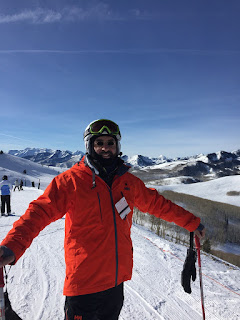 |
| Deer Valley |
 |
| the Arctic |
 |
| Vietnam at My Son |
 |
| Seoul, Korea |
 |
| Disney Cruise |
 |
| Northern Canada |
 |
| Hawaii Star Ball |
 |
| 70th BD Party at my home |
 |
| Havana, Cuba |
 |
| at family wedding with 3 sisters |
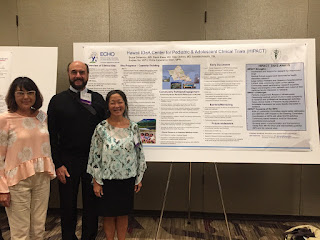 |
| At Pediatric Academic Society Meeting |
 |
| Yes, the little one is me.... |
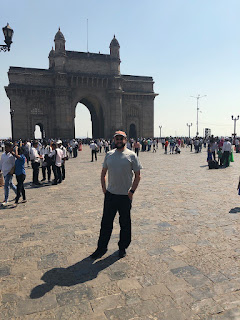 |
| India |
 |
| Taj Mahal Hotel |
 |
| Oman |
 |
| Dubai |
 |
| Big White, Canada |
 |
| Bratislava |
 |
| Pamplona, Spain |
 |
| Tiger's Nest, Bhutan |
 |
| Louisville, Kentucky |
 |
| Louisville |
 |
| Sheraton Waikiki |
 |
| Big White |
 |
| Japan |
 |
| Amori, Japan |
 |
| Hoi Anh, Vietnam |
 |
| Takayama, Japan |
 |
| Hempstead, New York |
 |
| Marianham, Sweden |
 |
| Vigeland Park, Oslo, Norway |
 |
| Eidfjord |
 |
| Bergen, Norway |
 |
| High School Graduation Pic |
 |
| UCSD research lab |
















